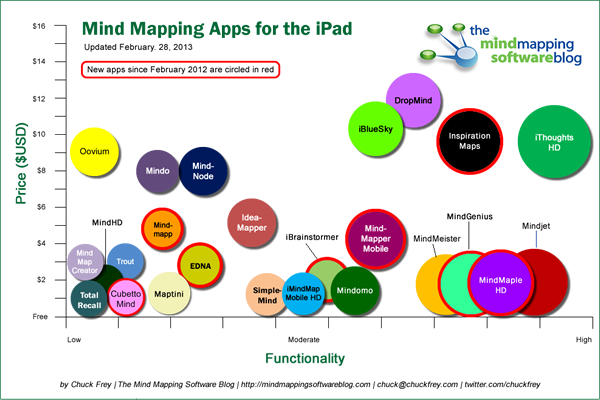How do the mind mapping apps for the iPad compare with each other? Here is a updated infographic that compares price vs. functionality, and what that translates into in terms of potential value to you.
The larger the circle, the greater the program’s value. New apps, launched since February 2012, are indicated by a red border around the circle. Please click on the image to view a larger version of this chart.
This chart was originally published a year ago this month, and is currently the most viewed page on the blog, by a 2-to-1 margin. Clearly, mind mapping on the iPad is hot right now! So much has happened in the last year I decided that I must update this infographic and provide you with up-to-date information. So I spent the last several weeks searching the AppStore for new mind mapping apps, downloading and evaluating them, and learning what has changed with the existing apps. Click here to view last year’s infographic, and you’ll see how things have changed in 12 short months.
As you can see, the market for mind mapping apps on the iPad is significantly more crowded than it was at this time last year. On the low end of the market, new simple apps like Cubetto Mind and EDNA have been launched, which meet the needs of people who are looking for a simple, free app to test the waters of mind mapping.
Desktop mind mapping developers jump into the game
The biggest trend in the last 12 months is the developers of desktop mind mapping software releasing their own apps for the iPad. Following the lead of Mindjet, which launched its first mobile apps in mid-2011, MindGenius, MindMapper and MindMaple have introduced new iPad apps for free. In addition, ThinkBuzan converted its pricing model to free to match its competitors, and to coincide with the launch of its iMindMap Freedom online workspace.
In most cases, these leading software developers enable the users of their desktop software to sychronize their maps between their mobile device and the desktop (Mindjet via its Connect online workspace and iMindMap via iMindMap Freedom) and MindGenius and MindMaple via Dropbox integration and mindMapper and via a shared web folder).
These apps are ideal for capturing the gist of an idea no matter where you are, in visual form. iPads are small enough and light enough that many people carry them everywhere, even using them as their primary camera! You can then transfer your fledgling idea to a desktop mind mapping program for further development and refinement.
There’s also a bit of a Trojan Horse strategy at work here. Many people are still dealing with tight budgets and can’t justify spending several hundred dollars to try out mind mapping to see if it works for them. But if they can pick up a free or low-cost (generally under US$10) mind mapping app for their iPad, it becomes very easy to justify trying out visual mapping. That makes mobile a valuable platform to bring new users to the party. A certain percentage of iPad users will love the experience, and will decide to make it part of their workflow and invest in the app’s companion desktop mind mapping tool.
Pioneering software company launches an iPad app
One pleasant surprise during the last year was the entrance of Inspiration Software into the family of iPad apps with its Inspiration Maps program, which debuted in April 2012. This is the developer who started the whole mind mapping software revolution, followed closely by MindMan (which later became MindManager).
For the last decade or more, Inspiration has been strongly focused on the education market. Considering the rate at which primary schools are adopting tablets as educational tools, the launch of Inspiration Maps should come as no surprise. At the time of its release, it could not exchange maps with the desktop Inspiration program, but that capability was added in September with the release of Inspiration 9.1 for the desktop. This opens up dozens of uses in the classroom. For example, this desktop-mobile integration makes it easy for teachers to develop mind maps as part of their curricula and then deploy them to students via the tablet-based app.
Update on the premium iPad apps
Several independent software developers who were among the first entrants into this booming genre of apps continue to be going strong, selling their apps at a premium price (approximately US$10) in return for greater functionality and ease of use: iThoughts HD and iBlueSky. The former has continued to add functionality on a regular basis. A quick perusal of the iThoughts Blog confirms that developer Craig Scott has been tirelessly working to ensure that iThoughts HD remains one of the best mind mapping apps for the iPad. If you give me a choice between a developer who launches an app and then hardly ever improves it or one who is constantly refining, fixing and expanding it, I’ll take the latter every time. That makes iThoughts HD an excellent investment, in my opinion.
iBlueSky doesn’t release updates as frequently as iThoughts does, but is more focused on providing an easy and intuitive user experience. As of version 3, iBlueSky is a Universal app, which means you buy it once and get an optimised experience on iPad, iPhone and iPod touch for no extra cost.
Conclusion
In conclusion, it has been an exciting year. I can’t wait to see what new developments the next 12 months have in store in the mind mapping apps for iPad space!
One thing is for sure: I will be in the middle of it, keeping you up-to-date on what’s new and improved, and providing you with insights on the best visual thinking tools for the iPad.
Related articles
A comparison of mind mapping apps for the iPad (2012)
Top 10 reasons why the iPad is the perfect platform for mind mapping


Leave a Reply